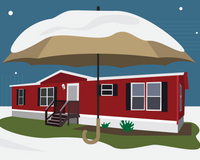Everyone needs a little fresh air this time of year, even if the great outdoors hasn’t caught up with us yet. This month we are discussing things you can do to help you breathe easier with mobile home ventilation.
Health implications of poor air quality
Americans spend about 90% of their overall time indoors; that’s quite a lot of time for breathing the same air!
The problem is that particles within a contained space tend to become more concentrated, especially the pollutants that lower air quality.
Exposure to air pollutants for an extended time can lead to a variety of health issues. A person may experience coughing and throat irritation, asthma attacks, difficulty breathing, allergies, or cardiovascular disease. Radon, a natural gas that enters homes from soil or water, remains the second leading cause of lung cancer here in the U.S.
Specific populations are at a greater risk for developing these health problems, particularly those with preexisting lung conditions (i.e., asthma or chronic bronchitis) and young children. Those living in communities with high poverty rates or limited access to healthcare are much more likely to be exposed to air pollutants.
Common indoor pollution sources
Common indoor pollution sources include but are not limited to:
- Lead dust
- Smoke
- Radon
- Carbon monoxide
- Fine particles (from sources such as candles or a fireplace)
Note there are also biological pollutants, as well. Substances like mold, dust mites, animal dander, and pollen all have the potential to trigger symptoms inside. That’s why improving air quality is so essential—and the solution to mobile home ventilation lies with the use of HVAC (Heating, Ventilation, and Air Conditioning) systems.
Improving mobile home air quality
Mobile home HVAC systems
Upgrading mobile home HVAC systems will drastically help improve air quality. The right model can work wonders, but first, you must consider a few things about your living space.
One element to factor in is whether or not your mobile home is fitted with ductwork. If so, your most budget-friendly option is probably a packaged system or split forced air system. A split forced air system is comprised of an indoor air handler and an outdoor condenser. When winter rolls around, the air handler acts similar to a furnace with a heat exchanger. If the system does not have this, it works alongside the condenser to function as an air conditioner and a heat pump.
On the other hand, a packaged system fuses the air handler and condenser into a single unit placed outside the home. A lot of mobile homeowners prefer these models since they take up a lot less space. However, because they are located outside, they will constantly be up against the elements as well as animals seeking refuge.
Think about the space you have. If you are living in a smaller home, it will be beneficial to go for a packaged system. If you have additional space for mobile home ventilation, a split system might be a better fit. It offers flexibility during the installation process, with the added advantage of uncomplicated maintenance.
For homes with no ductwork, the best option financially is to install a ductless mini split system. This unit has both indoor and outdoor parts, with the indoor component being much smaller. You may hang it on a wall or mount it to the flooring. Installation is relatively easy here, though the final cost may surpass that of a more traditional split system.
After you’ve decided on your ideal HVAC model, you can opt to add a few upgrades to ensure the system runs smoothly. A damper, for instance, will keep air from ductwork out of the furnace. A/C units and heat pumps can be outfitted with several accessories, such as a return box and grill, a return air filter, or a supply fitting.
Mobile home windows
You may also improve the air circulation of your mobile home from the outside. If the area where you live has suitable air quality, try to allow as much fresh air as possible by opening up doors and windows. If this is not an option, use air filtration, along with ventline exhaust fans for appliances like stoves. Be sure to swap the filter for a new one every few months for optimal use and safety.
Utilizing other fans in the household is another option for mobile home ventilation. Place a fan next to an open window to push pollutants out, or turn on a ceiling fan to improve airflow—regardless of whether windows are open or closed.
Mobile home sealing and waterproofing
You’ll additionally want to take the sealing and waterproofing of your home into account. Securing your home perimeter with skirting accessories has multiple uses, including giving off a “finished” appearance and creating a protective barrier around your home’s utilities. It also helps in warding off local critters or pests.
Air sealing your mobile home is an excellent way to better overall temperature regulation, too. A few key areas to pay attention to are:
- Air supply ducts
- Water heaters
- Exhaust fans
- Light fixtures
- Underbelly
Besides saving you money, sealing and waterproofing reduces the occurrence of rot, mold, and other forms of decay as the home ages over time. You’ll increase your comfort and your mobile home’s longevity simultaneously.
Freshen up your home with Star Mobile
Hit the reset button for your home with appliances from Star Mobile—just in time for the changing season. Browse our HVAC accessory collection to find the perfect fit!






